leeperry
Galvanically isolated his brain
- Joined
- Apr 23, 2004
- Posts
- 13,912
- Likes
- 2,097
Hi guys, pretty much every 6 months we see a new transport that becomes a game changer....async used to be all the rage, but now it's all about battery power, and LiFEPO4 grade at that due to their excellent specs.
A friend of mine who owns a non-USB Benchmark DAC-1 wanted to spend $500ish on a transport that wouldn't become obsolete 6 months later and that would provide him with the best bang for bucks...allowing him to keep it as an asset between his computer and his audio rig, as he plans on upgrading his DAC and headphones.
After a lot of brainstorming and googling, we both came to the conclusions that a perfect transports needs to:
-run in async mode, because isochronous is nice and all but async ensures better timings
-provide its own power, because the USB power exhibits very high ripple and isn't stable in essence as it's entirely dependent on the load of the other computer components(considering that the computer ATX PSU is shared). It's also prone to ground loops, interferences and so.
-come in a metal box in order to be shielded against EMI/RFI
-use two discrete clocks for 44.1 and 48kHz multiples
-support all possible sample rates up to 24/192, because more and more audio comes up in 88.2kHz form
Facts are that:
-only 12Mbit/s USB, S/PDIF & I2S allow galvanic isolation....I2S is by far the best solution(due to its discrete clock signal) but hardly any affordable DAC offers an input in this format.
-there doesn't seem to be any 12MBit/s USB transport that supports 88.2kHz and/or runs in async mode
-only USB to coax can be fully galvanically isolated if you don't plan on spending 3 grand on the DAC alone and want it async and 88.2kHz & >96kHz compatible
He also wanted to avoid all kludges w/ split USB cables, overpriced industrial hubs or external PSU's(whose cable is prone to catching interferences), DIY looking ABS enclosures...and keep it $500ish. So there was pretty much only one solution available on the market as far as we could see, the Tabla Pico: http://www.human-audio.com/humanaudioeng_tabla_pico.html

The genius of this interface is that once the battery is empty, it will silently switch to filtered USB power and then silently switch back to the battery once it will be full again. It will also automatically reload the battery when not in use. All the other battery powered transports I saw simply give up on ya once their battery's empty

The nice thing is that Human Audio is a european company so no need to worry about customs for EU citizens, and they even offered my friend a 2 weeks cooling-off period.
Unboxing:
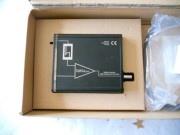
Its dimensions are 85x38x98 mm.
A male/male BNC adapter(not provided), for the cleanest signal transmission:

A good ole 4ft A/B Lacie Flat Cable:
The Tabla Pico connected to the DAC1: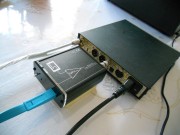
An overview of the whole rig:
He's currently running a non-USB Benchmark DAC1 + Lehmann Linear Black Cube + Audio Technica ES-10 & AKG K340.
He told me that it made quite a change from his previous Toslink cable, but the opposite would have been hard to believe when we know that Toslink usually stands in the +1000ps jitter region. The improvement could/would/should have been more drastic but the DAC1 seems to run a mandatory 192kHz ASRC pass on all incoming signals using the S/PDIF input of a SRC chip, so that will drastically color the sound. I advised him to shoot for a DAC that runs the market leading WM8804/WM8805 reclocking S/PDIF receiver. You're only as strong as your weakest link, and S/PDIF being a protocol that's based on a clock recovery mechanism you should make sure that both transmitter and receiver are top performers.
My friend also bought a power plug/female USB adapter so he could let the battery reload even when the computer's turned off:

All this said, he left it to me for a few days so I could give him more thoughts about it...this proposition was hard to refuse

Being very curious, I cracked it open with his permission:

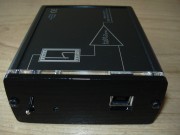

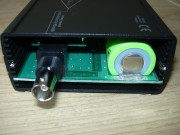
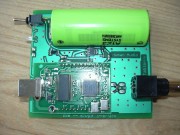
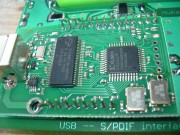
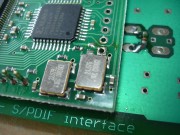
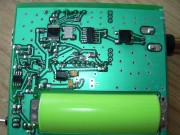
so we have the big LiFePO4 battery, the two discrete clocks, the pulse transformer and a whole bunch of -most likely- voltage regulators whose surface has been erased in order to protect their R&D I would guess.
I planned on trying it on my Stello Eximus DP-1 so I installed a BNC/RCA adapter:
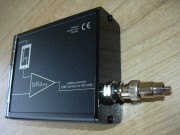
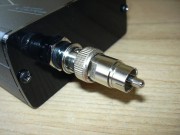
and here we go:
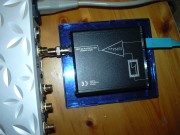
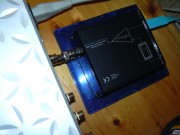
Well, how does it sound then? Well, very good as you would expect =)
The only drawback is that the Eximus DP-1 uses the rather old CS8416 chip on its coax input, and jitter performance is not that good...this DAC has a great sounding XMOS based USB input, even an I2S input but S/PDIF is not its strong point...but yes, SQ was indeed excellent. As good as CS8416 can sound IMO, and yes I did try a few other transports on the DP-1.
My friend is in the market for an Audio-GD DAC using WM8805, so I will update this thread in due time.
My conclusions to this small review would be that if you want the most technically advanced USB>coax transport for the highest bang/bucks on the market, this little unit should be on your short list. They'll even provide a 2 weeks cooling-off period, so you can essentially try it at the price of shipping.
It's using the stock EVO/hiface m2tech drivers so it will only run on Windows & MacOS, as this italian company recently gave up on providing Linux drivers due to intellectual property patents they don't plan on sharing. So if you're a Linux head, you should look elsewhere.
If any other owners of this wonderful little black box hang around, feel free to share your experience too

A friend of mine who owns a non-USB Benchmark DAC-1 wanted to spend $500ish on a transport that wouldn't become obsolete 6 months later and that would provide him with the best bang for bucks...allowing him to keep it as an asset between his computer and his audio rig, as he plans on upgrading his DAC and headphones.
After a lot of brainstorming and googling, we both came to the conclusions that a perfect transports needs to:
-run in async mode, because isochronous is nice and all but async ensures better timings
-provide its own power, because the USB power exhibits very high ripple and isn't stable in essence as it's entirely dependent on the load of the other computer components(considering that the computer ATX PSU is shared). It's also prone to ground loops, interferences and so.
-come in a metal box in order to be shielded against EMI/RFI
-use two discrete clocks for 44.1 and 48kHz multiples
-support all possible sample rates up to 24/192, because more and more audio comes up in 88.2kHz form
Facts are that:
-only 12Mbit/s USB, S/PDIF & I2S allow galvanic isolation....I2S is by far the best solution(due to its discrete clock signal) but hardly any affordable DAC offers an input in this format.
-there doesn't seem to be any 12MBit/s USB transport that supports 88.2kHz and/or runs in async mode
-only USB to coax can be fully galvanically isolated if you don't plan on spending 3 grand on the DAC alone and want it async and 88.2kHz & >96kHz compatible
He also wanted to avoid all kludges w/ split USB cables, overpriced industrial hubs or external PSU's(whose cable is prone to catching interferences), DIY looking ABS enclosures...and keep it $500ish. So there was pretty much only one solution available on the market as far as we could see, the Tabla Pico: http://www.human-audio.com/humanaudioeng_tabla_pico.html
The genius of this interface is that once the battery is empty, it will silently switch to filtered USB power and then silently switch back to the battery once it will be full again. It will also automatically reload the battery when not in use. All the other battery powered transports I saw simply give up on ya once their battery's empty

The nice thing is that Human Audio is a european company so no need to worry about customs for EU citizens, and they even offered my friend a 2 weeks cooling-off period.
Unboxing:


Its dimensions are 85x38x98 mm.
A male/male BNC adapter(not provided), for the cleanest signal transmission:

A good ole 4ft A/B Lacie Flat Cable:

The Tabla Pico connected to the DAC1:

An overview of the whole rig:

He's currently running a non-USB Benchmark DAC1 + Lehmann Linear Black Cube + Audio Technica ES-10 & AKG K340.
He told me that it made quite a change from his previous Toslink cable, but the opposite would have been hard to believe when we know that Toslink usually stands in the +1000ps jitter region. The improvement could/would/should have been more drastic but the DAC1 seems to run a mandatory 192kHz ASRC pass on all incoming signals using the S/PDIF input of a SRC chip, so that will drastically color the sound. I advised him to shoot for a DAC that runs the market leading WM8804/WM8805 reclocking S/PDIF receiver. You're only as strong as your weakest link, and S/PDIF being a protocol that's based on a clock recovery mechanism you should make sure that both transmitter and receiver are top performers.
My friend also bought a power plug/female USB adapter so he could let the battery reload even when the computer's turned off:
All this said, he left it to me for a few days so I could give him more thoughts about it...this proposition was hard to refuse

Being very curious, I cracked it open with his permission:








so we have the big LiFePO4 battery, the two discrete clocks, the pulse transformer and a whole bunch of -most likely- voltage regulators whose surface has been erased in order to protect their R&D I would guess.
I planned on trying it on my Stello Eximus DP-1 so I installed a BNC/RCA adapter:


and here we go:


Well, how does it sound then? Well, very good as you would expect =)
The only drawback is that the Eximus DP-1 uses the rather old CS8416 chip on its coax input, and jitter performance is not that good...this DAC has a great sounding XMOS based USB input, even an I2S input but S/PDIF is not its strong point...but yes, SQ was indeed excellent. As good as CS8416 can sound IMO, and yes I did try a few other transports on the DP-1.
My friend is in the market for an Audio-GD DAC using WM8805, so I will update this thread in due time.
My conclusions to this small review would be that if you want the most technically advanced USB>coax transport for the highest bang/bucks on the market, this little unit should be on your short list. They'll even provide a 2 weeks cooling-off period, so you can essentially try it at the price of shipping.
It's using the stock EVO/hiface m2tech drivers so it will only run on Windows & MacOS, as this italian company recently gave up on providing Linux drivers due to intellectual property patents they don't plan on sharing. So if you're a Linux head, you should look elsewhere.
If any other owners of this wonderful little black box hang around, feel free to share your experience too








